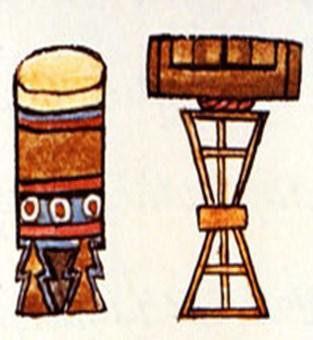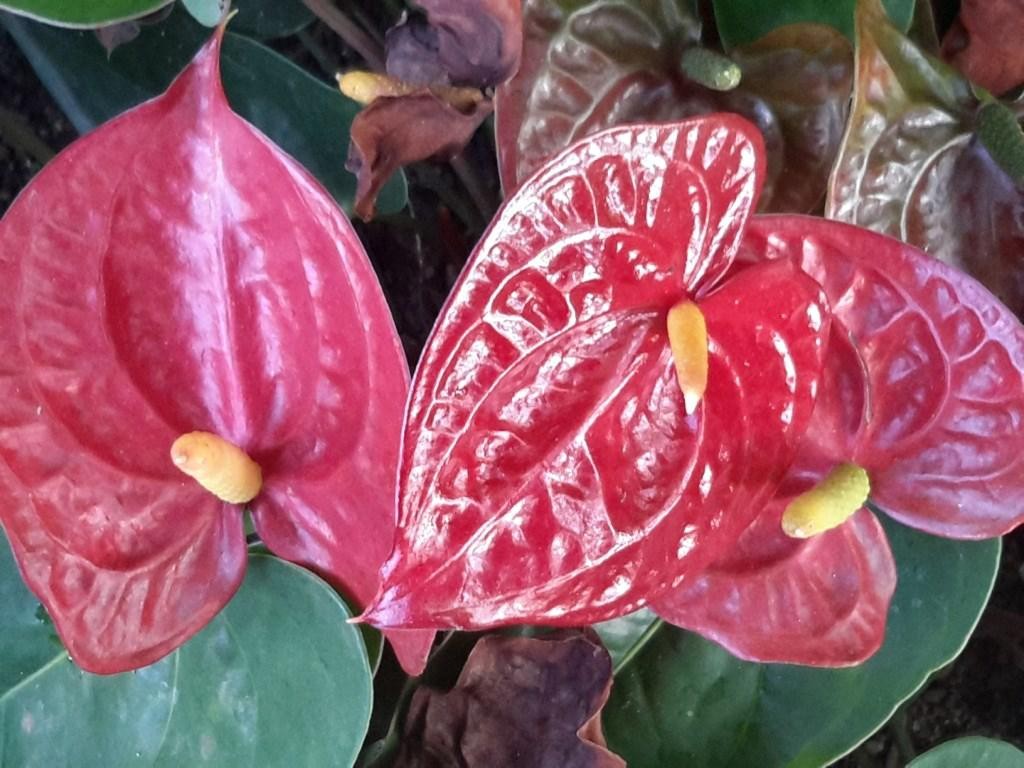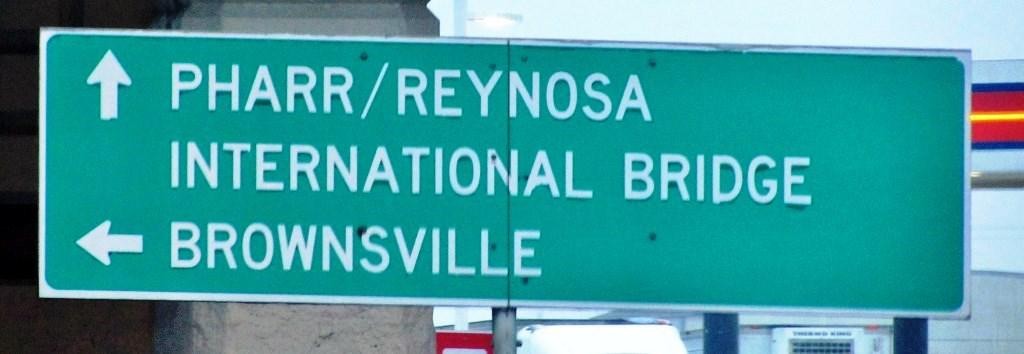By Dan and Lisa Goy from the February 2018 Edition
March 14, 2016 (Day 68)
Teotihuacan, State of Mexico “Distrito Federal” – March 14 (Day 68)
Day 5 in San Juan Teotihuacan, booked into at the Teotihuacan the RV Park, and we thought it was time for a visit to the nearby archeological site, Teotihuacan, which predates the Aztecs in Mexico City by a thousand years. We first visited these Pyramids in 1985 when staying with the Resendiz family in Coyoacán, one of the 16 boroughs in Mexico City. We returned in 2002, stayed at the Teotihuacan RV Park in December, where we froze, for our 2nd tour of Teotihuacan. It was impressive when we first saw Teotihuacan, and is still impressive seeing it for the 3rd time. Since our last visit in 2002, more excavation has been done on the site, with more of Teotihuacan revealed to the public.
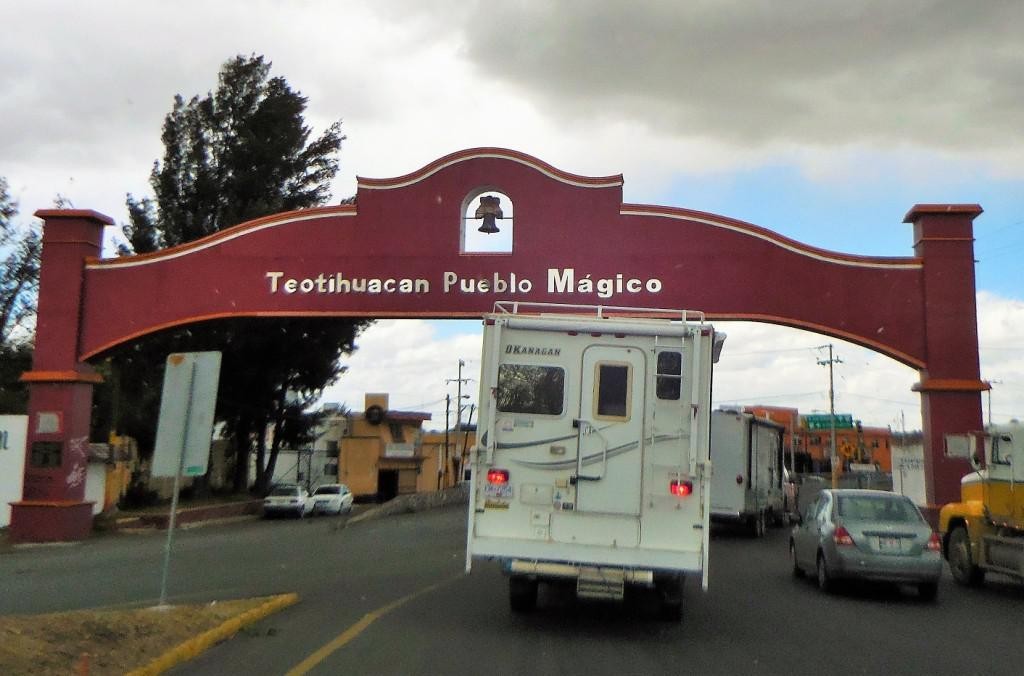
The gang spent 4 hours, which was also impressive given the heat, almost 30°C in the shade. Bruce, of course, stayed later than anyone else, scouring each inch of the site, for at least an-other 4 hours. Fortunately, you are still able to climb both the Pyramid of the Sun and Moon, which is prohibited at many other Meso-American pyramids. We have since learned that the Rolling Stones visited Teotihuacan the day after our visit; good thing Bruce did not know as he would have slept on site over-night and been arrested. Given that the Pyramid of the Sun is the 3rd largest such structure in the world, and the Avenue of the Dead is 4 km in length, there is plenty to see. On our re-turn, we readied ourselves and RVs to depart the next day. We also had an impromptu gathering in the afternoon sun before heading off to some grocery shopping at the local Chedraui.
Ancient Teotihuacan
Teotihuacan is an ancient Mesoamerican city, located in a subvalley of the Valley of Mexico, which is situated in the State of Mexico, 40 kilometres (25 mi) northeast of modern day Mexico City, known today as the site of many of the most architecturally significant Mesoamerican pyramids built in the pre-Columbian Americas.

At its zenith, perhaps in the first half of the 1st millennium AD, Teotihuacan was the largest city in the pre-Columbian Americas, with a population estimated at 125,000 or more, making it at least the sixth largest city in the world during at this time.
Apart from the pyramids, Teotihuacan is also anthropologically significant for its complex, multi-family residential compounds, the Avenue of the Dead and the small portion of its vibrant murals that have been exceptionally well preserved. Additionally, Teotihuacan exported fine obsidian tools that garnered high prestige and widespread usage throughout Mesoamerica. The city is believed to have been established around 100 BC, with major monuments continuously under construction until about 250 AD. The city may have lasted until some time be-tween the 7th and 8th centuries AD, but its major monuments were sacked and systematically burned around 550 AD.
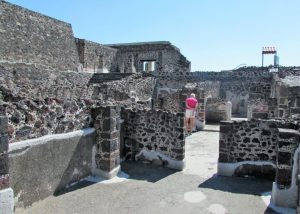 Teotihuacan was even home to multi-floor apartment com-pounds built to accommodate this large population. The term Teotihuacan (or Teotihuacano) is also used for the whole civilization and cultural complex associated with the site. Although it is a subject of debate whether Teotihuacan was the centre of a state empire, its influence throughout Mesoamerica is well documented; evidence of Teotihuacano presence can be seen at numerous sites in Veracruz and the Maya region. The later Aztecs saw these magnificent ruins and claimed a common ancestry with the Teotihuacanos, modifying and adopting aspects of their culture. The ethnicity of the inhabitants of Teotihuacan is also a subject of much debate. Possible candidates are the Nahua, Otomi or Totonac ethnic groups. Scholars have also suggested that Teotihuacan was a multi-ethnic state. The site covers a total surface area of 83 square kilometres (32 sq mi) and was designated a UNESCO World Heritage Site in 1987. It is the most visited archaeological site in Mexico.
Teotihuacan was even home to multi-floor apartment com-pounds built to accommodate this large population. The term Teotihuacan (or Teotihuacano) is also used for the whole civilization and cultural complex associated with the site. Although it is a subject of debate whether Teotihuacan was the centre of a state empire, its influence throughout Mesoamerica is well documented; evidence of Teotihuacano presence can be seen at numerous sites in Veracruz and the Maya region. The later Aztecs saw these magnificent ruins and claimed a common ancestry with the Teotihuacanos, modifying and adopting aspects of their culture. The ethnicity of the inhabitants of Teotihuacan is also a subject of much debate. Possible candidates are the Nahua, Otomi or Totonac ethnic groups. Scholars have also suggested that Teotihuacan was a multi-ethnic state. The site covers a total surface area of 83 square kilometres (32 sq mi) and was designated a UNESCO World Heritage Site in 1987. It is the most visited archaeological site in Mexico.
Site layout
The city’s broad central avenue, called “Avenue of the Dead” (a translation from its Nahuatl name Miccoatli), is flanked by impressive ceremonial architecture, including the immense Pyramid of the Sun (third largest in the World after the Great Pyramid of Cholula and the Great Pyramid of Giza). Pyramid of the Moon and The Ciudadela with Temple of the Feathered Serpent Quetzalcoatl are placed at the both ends of Avenue while Palace museum Quetzalpapálot, fourth basic structure of site, situated between two main pyramids. Along the Avenue are many smaller taludtablero platforms also. The Aztecs believed they were tombs, inspiring the name of the avenue. Scholars have now established that these were ceremonial platforms that were topped with temples.
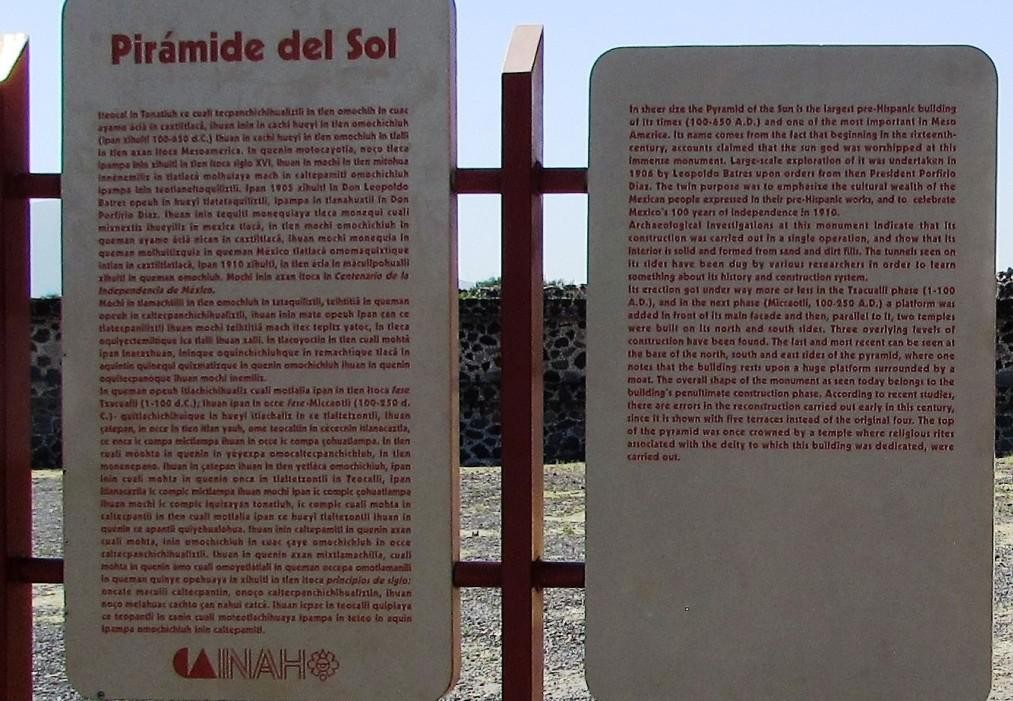
The Avenue of the Dead is roughly forty meters wide and four kilometers long. Further down the Avenue of the Dead, after a small river, is the area known as the Citadel, containing the ruined Temple of the Feathered Serpent Quetzalcoatl. This area was a large plaza, surrounded by temples that formed the religious and political center of the city. The name “Citadel” was given to it by the Spanish, who believed it was a fort. Most of the common people lived in large apartment buildings spread across the city. Many of the buildings contained workshops where artisans produced pottery and other goods.
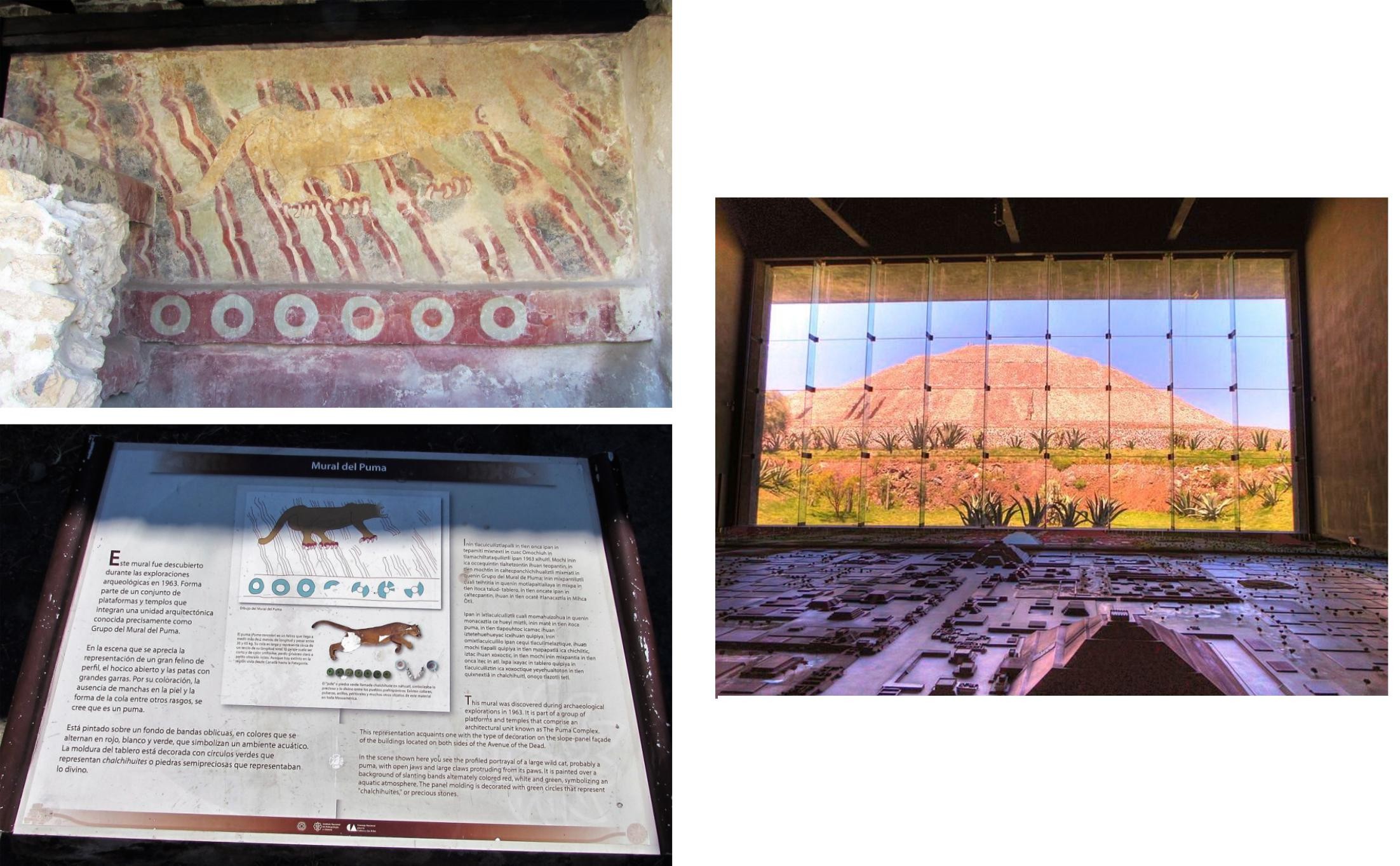
The geographical layout of Teotihuacan is a good example of the Mesoamerican tradition of planning cities, settlements, and buildings as a representation of the view of the Universe. Its urban grid is aligned to precisely 15.5º east of North. One theory says this is due to the fact that the sun rose at that same angle during the same summer day each year. Settlers used the alignment to calibrate their sense of time or as a marker for planting crops or performing certain rituals. Another theory is that there are numerous ancient sites in Mesoamerica that seem to be oriented with the tallest mountain in their given area. This appears to be the case at Teotihuacan, although the mountain to which it is oriented is not visible from within the Teotihuacan complex due to a closer mountain ridge. Pecked cross circles throughout the city, and in the surrounding regions, indicate how the people managed to maintain the urban grid over long distances. It also enabled them to orient the Pyramids to the distant mountain that was out of sight.
The Ciudadela was completed during the Miccaotli phase, and the Pyramid of the Sun underwent a complex series of addi-tions and renovations. The Great Compound was constructed across the Avenue of the Dead, west of Ciudadela. This was probably the city’s marketplace. The existence of a large market in an urban center of this size is strong evidence of state or-ganization. Teotihuacan was, at that point, simply too large and too complex to have been politically viable as a chiefdom. The Ciudadela is a great enclosed compound, capable of holding 100,000 people. About 700,000 cubic meters (yards) of material was used to construct its buildings. Its central feature is the Temple of Quetzalcoatl, which was flanked by upper class apartments. The entire compound was designed to overwhelm visitors.
Name Teotihuacan
The name Teōtīhuacan was given by the Nahuatl-speaking Aztecs, centuries after the fall of the city around 550 AD. The term has been glossed as “birthplace of the gods”, or “place where gods were born”, reflecting Nahua creation myths that were said to occur in Teotihuacan. Nahuatl scholar, Thelma D. Sullivan, interprets the name as “place of those who have the road of the gods.” This is because the Aztecs believed that the gods created the universe at that site. The name is pronounced [te.o ː t i ː ˈ waka ː n] in Nahuatl, with the accent on the syllable wa.
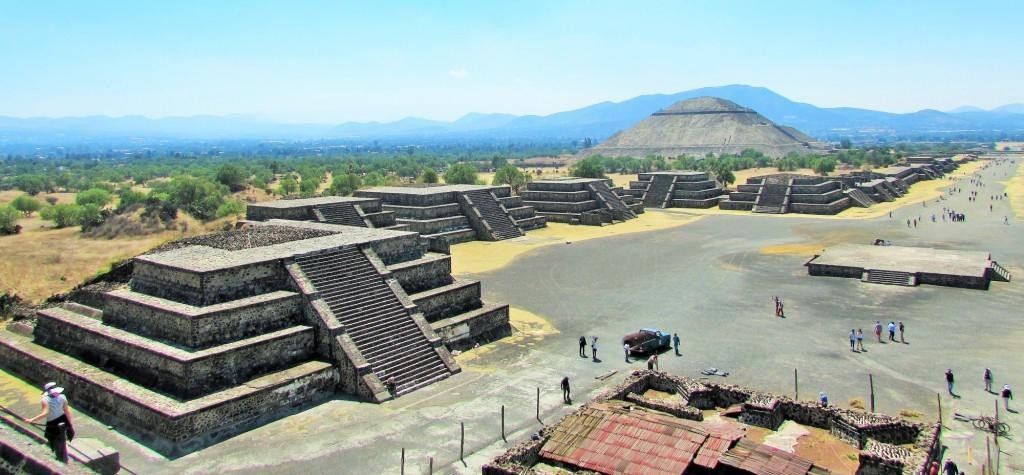
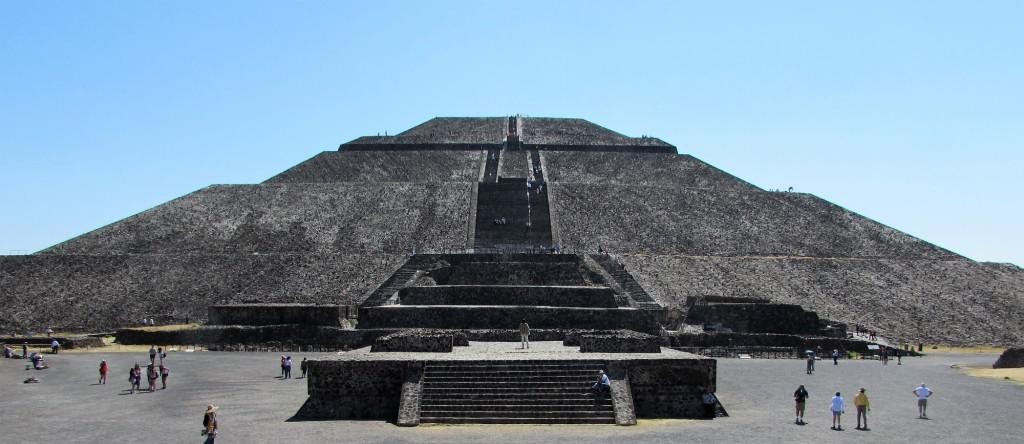
By normal Nahuatl orthographic conventions, a written accent would not appear in that position. Both this pronunciation and Spanish pronunciation: [te.otiwaˈkan] are used, and both spellings appear in this article.
The original name of the city is unknown, but it appears in hieroglyphic texts from the Maya region as puh, or “Place of Reeds”. This suggests that, in the Maya civilization of the Classic period, Teotihuacan was understood as a Place of Reeds similar to other Postclassic Central Mexican settlements that took the name of Tollan, such as Tula Hidalgo and Cholula. This naming convention led to much confusion in the early 20th century, as scholars debated whether Teotihuacan or Tula-Hidalgo was the Tollan described by 16th-century chronicles. It now seems clear that Tollan may be understood as a generic Nahua term applied to any large settlement. In the Meso-american concept of urbanism, Tollan and other language equivalents serve as a metaphor, linking the bundles of reeds and rushes that formed part of the lacustrine environment of the Valley of Mexico and the large gathering of people in a city.
Teotihuacan History
The early history of Teotihuacan is actually quite mysterious, and the origin of its founders is uncertain. Around 300 BC, people of the central and southeastern area of Mesoamerica began to gather into larger settlements. Teotihuacan was the largest urban center of Mesoamerica before the Aztecs, almost 1000 years prior to their era. The city was already in ruins by the time of the Aztecs. For many years, archaeologists believed it was built by the Toltec. This belief was based on colonial period texts, such as the Florentine Codex, which attributed the site to the Toltecs. However, the Nahuatl word “Toltec” generally means “craftsman of the highest level” and may not always refer to the Toltec civilization centered at Tula, Hidalgo. Since Toltec civilization flourished centuries after Teotihuacan, the people could not have been the city’s founders.
In the Late Formative era, a number of urban centers arose in central Mexico. The most prominent of these appears to have been Cuicuilco, on the southern shore of Lake Texcoco. Schol-ars have speculated that the eruption of the Xitle volcano may have prompted a mass emigration out of the central valley and into the Teotihuacan valley. These settlers may have founded or accelerated the growth of Teotihuacan.
Other scholars have put forth the Totonac people as the founders of Teotihuacan. There is evidence that at least some of the people living in Teotihuacan emigrated from those areas influenced by the Teotihuacano civilization, including the Zapotec, Mixtec and Maya peoples. The builders of Teotihuacan took ad-vantage of the geography in the Basin of Mexico. From the swampy ground, they constructed raised beds called chinampas, creating high agricultural productivity despite old methods of cultivation. This allowed for the formation of channels, and subsequently canoe traffic, to transport food from farms around the city. The earliest buildings at Teotihuacan date to about 200 BC. The largest pyramid, the Pyramid of the Sun, was completed by AD 100.
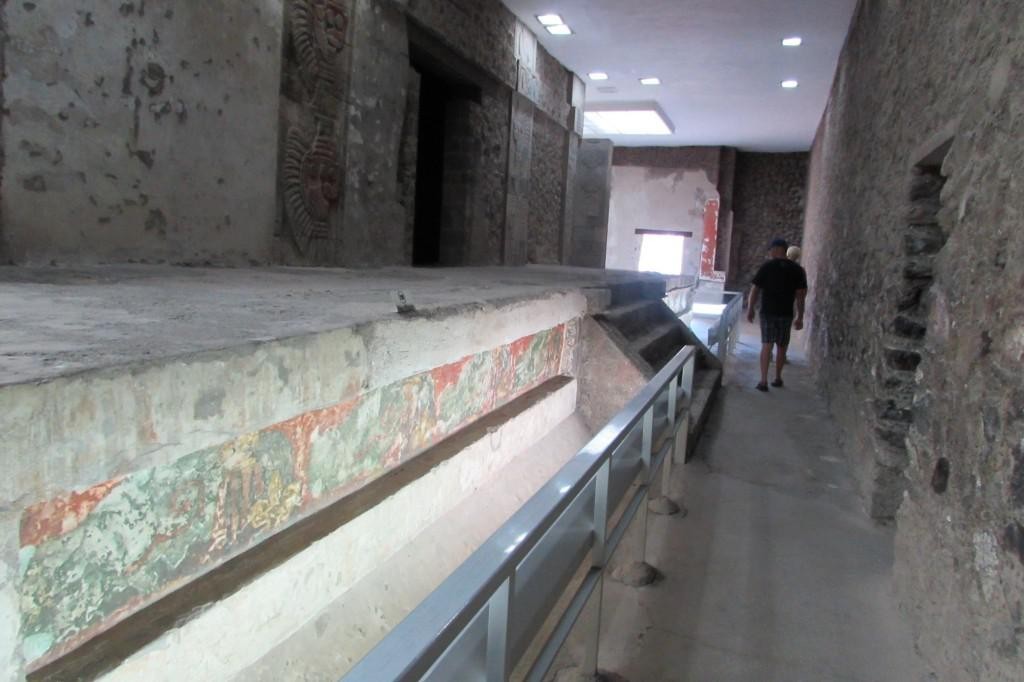
Year 378: “Conquest” of Tikal
In January 378, while Spearthrower Owl supposedly ruled in Teotihuacan, the warlord Siyah K’ak’ “conquered” Tikal, remov-ing and replacing the Maya king, with support from El Peru and Naachtun, as recorded by Stela 31 at Tikal and other monuments in the Maya region. In 378, a group of Teotihuacanos organized a coup d’état in Tikal, Guatemala. This was not the Teotihuacan state; it was a group of the Feathered Serpent people, thrown out from the city. The Feathered Serpent Pyra-mid was burnt, all the sculptures were torn from the temple, and another platform was built to efface the façade.
Year 426: “Conquest” of Copán and Quiriguá
In 426, the Copán ruling dynasty was created with K’inich Yax K’uk’ Mo’ as their first king. The Dynasty goes on to have sixteen rulers. Copán is located in modern day Honduras, as described by Copán Altar Q. Soon thereafter, Yax K’uk’ Mo’ installs Tok Casper as king of Quiriguá, about 50 km north of Copán. The city reached its peak in 450 CE, when it was the center of a powerful culture whose influence extended through much of the Mesoamerican region. At its peak, the city covered over 30 km² (over 111⁄2 square miles), and perhaps housed a population of 150,000 people, with one estimate reaching as high as 250,000. Various districts in the city housed people from across the Teotihuacano region of influence, which spread south as far as Guatemala. Notably absent from the city are fortifications and military structures.
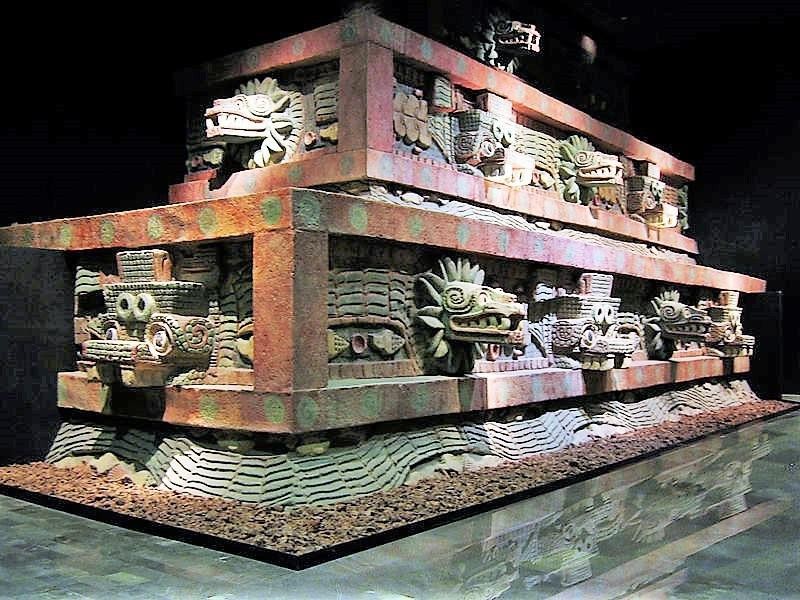
The nature of political and cultural interactions between Teotihuacan and the centers of the Maya region (as well as else-where in Mesoamerica) has been a long-standing and significant area for debate. Substantial exchange and interaction occurred over the centuries from the Terminal Preclassic to the Mid-Classic period. “Teotihuacan-inspired ideologies” and motifs persisted at Maya centers into the Late Classic, long after Teotihuacan itself had declined. However, scholars debate the extent and degree of Teotihuacano influence. Some believe that it had direct and militaristic dominance; others that adoption of “foreign” traits was part of a selective, conscious, and bi-directional cultural diffusion. New discoveries have suggested that Teotihuacan was not much different in its interactions with other centers from the later empires, such as the Toltec and Aztec. It is believed that Teotihuacan had a major influence on the Preclassic and Classic Maya, most likely by conquering several Maya centers and regions, including Tikal and the region of Peten, and influencing Maya culture.
x
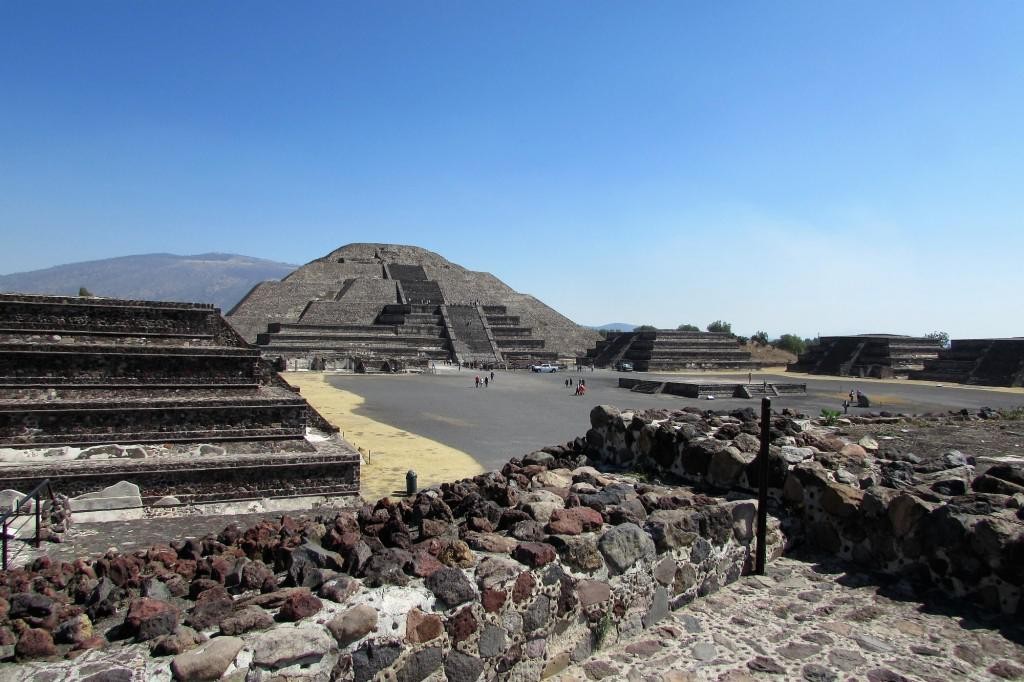
Restored portions of Teotihuacan architecture show the typical Mesoamerican use of red paint complemented on gold and jade decoration upon marble and granite.Architectural styles prominent at Teotihuacan are found widely dispersed at a number of distant Mesoamerican sites, which some researchers having interpreted this as evidence for Teoti-huacan’s far-reaching interactions and political or militaristic dominance. The city was a center of industry, home to many potters, jewelers, and craftsmen. Teotihuacan is known for producing a great number of obsidian artifacts. No ancient Teotihuacano nonideographic texts are known to exist (or known to have existed). Inscriptions from Maya cities show that Teotihuacan nobility traveled to, and perhaps conquered, local rulers as far away as Honduras. Maya inscriptions note an individual nicknamed by scholars as “Spearthrower Owl”, apparently ruler of Teotihuacan, who reigned for over 60 years and installed his relatives as rulers of Tikal and Uaxactun in Guatemala.
Scholars have based interpretations about the culture at Teotihuacan on archaeology, the murals that adorn the site (and others, like the Wagner Murals, found in private collections), and hieroglyphic inscriptions made by the Maya describing theirmencounters with Teotihuacano conquerors. The creation of murals, perhaps tens of thousands of murals, reached its height between 450 and 650. The artistry of the painters was unrivaled in Mesoamerica and has been compared with that of painters in Renaissance Florence, Italy.
Collapse
Scholars had thought that invaders attacked the city in the 7th or 8th century, sacking and burning it. More recent evidence, however, seems to indicate that the burning was limited to the structures and dwellings associated primarily with the ruling class. Some believe this suggests that the burning was from an internal uprising. They say the invasion theory is flawed be-cause early archaeological work on the city was focused exclusively on the palaces and temples, places used by the upper classes. Because all of these sites showed burning, archaeologists concluded that the whole city was burned. Instead, it is now known that the destruction was centered on major civic structures along the Avenue of the Dead. Some statues seem to have been destroyed methodically, with their fragments dispersed.
Evidence for population decline beginning around the 6th century lends some support to the internal unrest hypothesis. The decline of Teotihuacan has been correlated to lengthy droughts related to the climate changes of 535–536. This theory of ecological decline is supported by archaeological remains that show a rise in the percentage of juvenile skeletons with evidence of malnutrition during the 6th century. Which is why there is different evidence that helps indicate that famine is most likely one of the more possible reasons for the decline of Teotihuacan. The majority of their food came from agricul-ture, they grew things such as maize, bean, amaranth, green tomatoes, and pumpkin. But their harvest was not nearly sufficient enough to feed a population as big as it is believed lived in Teotihuacan. This finding does not conflict with either of the above theories, since both increased warfare and internal unrest can also be effects of a general period of drought and famine. Other nearby centers such as Cholula, Xochicalco, and Cacaxtla competed to fill the power void left by Teotihuacan’s decline. They may have aligned themselves against Teotihuacan to re-duce its influence and power. The art and architecture at these sites emulate Teotihuacan forms, but also demonstrate an eclectic mix of motifs and iconography from other parts of Mesoamerica, particularly the Maya region.
The sudden destruction of Teotihuacan is not uncommon for Mesoamerican city-states of the Classic and EpiClassic period. Many Maya states suffered similar fates in the coming centu-ries, a series of events often referred to as the Classic Maya collapse. Nearby in the Morelos valley, Xochicalco was sacked and burned in 900 and Tula met a similar fate around 1150. There is also a theory that the collapse of Teotihuacan was caused by its agriculture being devastated by the 535 AD eruption of the Ilopango volcano in El Salvador.
Culture
Archaeological evidence suggests that Teotihuacan was a multi-ethnic city, with distinct quarters occupied by Otomi, Zapotec, Mixtec, Maya, and Nahua peoples. The Totonacs have always maintained that they were the ones who built it. The Aztecs repeated that story, but it has not been corroborated by archaeological findings. In 2001, Terrence Kaufman presented linguistic evidence suggesting that an important ethnic group in Teotihuacan was of Totonacan or Mixe Zoquean linguistic affiliation. He uses this to explain general influences from Totonacan and Mixe Zoquean languages in many other Mesoamerican languages, whose people did not have any known history of con-tact with either of the above mentioned groups. Other scholars maintain that the largest population group must have been of Otomi ethnicity, because the Otomi language is known to have been spoken in the area around Teotihuacan both before and after the Classic period and not during the middle period.
Religion
The consensus among scholars is that the primary deity of Teotihuacan was the Great Goddess of Teotihuacan. The dominant civic architecture is the pyramid. Politics were based on the state religion; religious leaders were the political leaders. Teotihuacanos practiced human sacrifice: human bodies and animal sacrifices have been found during excavations of the pyramids at Teotihuacan. Scholars believe that the people offered human sacrifices as part of a dedication when buildings were expanded or constructed. The victims were probably enemy warriors captured in battle and brought to the city for ritual sacrifice to ensure the city could prosper. Some men were decapitated, some had their hearts removed, others were killed by being hit several times over the head, and some were buried alive. Animals that were considered sacred and represented mythical powers and military were also buried alive, imprisoned in cages: cougars, a wolf, eagles, a falcon, an owl, and even venomous snakes. Numerous stone masks have been found at Teotihuacan, and have been generally believed to have been used during a funerary context, although some scholars call this into question, noting that masks “do not seem to have come from burials”.
Residency
Teotihuacan was a mix of residential and work areas. Upper-class homes were usually compounds that housed many such families, and one compound was found that was capable of housing between sixty and eighty families. Such superior residences were typically made of plaster, each wall in every sec-tion elaborately decorated with murals. These compounds or apartment complexes were typically found within the city ce-ter. The vast lakes of the Basin of Mexico provided the opportunity for people living around them to construct productive raised beds, or chinampas, from swampy muck, construction that also produced channels between the beds. Different sections of the city housed particular ethnic groups and immigrants. Typically, multiple languages were spoken in these sections of the city.
Archaeological site
Knowledge of the huge ruins of Teotihuacan was never completely lost. After the fall of the city, various squatters lived on the site. During Aztec times, the city was a place of pilgrimage and identified with the myth of Tollan, the place where the sun was created. Today, Teotihuacan is one of the most noted ar-chaeological attractions in Mexico.
Excavations and investigations
In the late 17th century, Carlos de Sigüenza y Góngora (1645– 1700) made some excavations around the Pyramid of the Sun. Minor archaeological excavations were conducted in the 19th century. In 1905, Mexican archaeologist and government official, in the regime of Porfirio Díaz, Leopoldo Batres led a major project of excavation and restoration. The Pyramid of the Sun was restored to celebrate the centennial of the Mexican War of Independence in 1910. The site of Teotihuacan was the first to be expropriated for the national patrimony under the Law of Monuments (1897), giving jurisdiction under legislation for the Mexican state to take control. Some 250 plots were farmed on the site. Peasants who had been farming portions were ordered to leave and the Mexican government eventually paid some compensation to those individuals. A feeder train line was built to the site in 1908, which allowed the efficient hauling of material from the excavations and later to bring tourists to the site. In 1910, the International Congress of Americanists met in Mexico, coinciding with the centennial celebrations, and the distinguished delegates, such as its president Eduard Seler and vice president Franz Boas were taken to the newly finished excavations. Further excavations at the Ciudadela were carried out in the 1920s, supervised by Manuel Gamio. Other sections of the site were excavated in the 1940s and 1950s. The first site-wide project of restoration and excava-tion was carried out by INAH from 1960 to 1965, supervised by Jorge Acosta. This undertaking had the goals of clearing the Avenue of the Dead, consolidating the structures facing it, and excavating the Palace of Quetzalpapalotl.
During the installation of a “sound and light” show in 1971, workers discovered the entrance to a tunnel and cave system underneath the Pyramid of the Sun. Although scholars long thought this to be a natural cave, more recent examinations have established the tunnel was entirely manmade. The interior of the Pyramid of the Sun has never been fully excavated. In 1980-82, another major program of excavation and restoration was carried out at the Pyramid of the Feathered Serpent and the Avenue of the Dead complex. Most recently, a series of excavations at the Pyramid of the Moon have greatly expanded evidence of cultural practices.
Recent discoveries
In late 2003, a tunnel beneath the Temple of the Feathered Serpent was accidentally discovered by Sergio Gómez Chávez and Julie Gazzola, archaeologists of the National Institute of Anthropology and History (INAH). After days of heavy rain-storm, Gómez Chávez noticed that a nearly three-foot-wide sinkhole occurred near the foot of the temple pyramid. First trying to examine the hole with a flashlight from above, Gómez could see only darkness so, tied with a line of heavy rope around his waist, he was lowered by several colleagues and, descending into the murk, he realized it was a perfectly cylindrical shaft. At the bottom, he came to rest in apparently ancient construction a man-made tunnel, blocked in both directions by immense stones. Gómez was aware that archaeologists had previously discovered a narrow tunnel underneath the Pyramid of the Sun, and supposed he was now observing a kind of similar mirror tunnel, leading to a subterranean chamber beneath the Temple of the Feathered Serpent. He erected a tent over the sinkhole to preserve it from the hundreds of thousands of tourists that visit Teotihuacan. Researchers re-ported that the tunnel was believed to have been sealed in 200 CE.
Preliminary planning of the exploration and fundraising took more than six years.
Before the start of excavations, beginning in the early months of 2004, Dr. Victor Manuel Velasco Herrera, from the UNAM Institute of Geophysics, determined, with the help of ground-penetrating radar (GPR) and a team of some 20 archaeologists and workers, the approximate length of the tunnel and the presence of internal chambers. They scanned the earth under the Ciudadela, returning every afternoon to upload the results to Gómez’s computers. By 2005, the digital map was complete. The archaeologists explored the tunnel with a remote controlled robot called Tlaloc II-TC, equipped with an infrared camera and a laser scanner that generates 3D visualization to perform three-dimensional register of the spaces beneath the temple. A small opening in the tunnel wall was made and the scanner captured the first images, 37 meters into the passage.
In 2009, the government granted Gómez permission to dig. By the end of 2009, archaeologists of the INAH located the en-trance to the tunnel that leads to galleries under the pyramid, where the remains of rulers of the ancient city might have been deposited. In August 2010, Gómez Chávez, now director of Tlalocan Project: Underground Road, announced that INAH’s investigation of the tunnel – closed nearly 1,800 years ago by Teotihuacan dwellers will proceed. The INAH team, which consisted of about 30 people supported by national and inter-national advisors at the highest scientific levels, tried to enter the tunnel in September October 2010. This excavation, the deepest made at the Pre-Hispanic site, was part of the commemorations of the 100th anniversary of archaeological excava-tions at Teotihuacan and its opening to the public.
It was mentioned that the underground passage runs under Feathered Serpent Temple, and the entrance is located a few meters away from the temple at the expected place, deliberately sealed with large boulders nearly 2,000 years ago. The hole that had appeared during the 2003 storms was not the actual entrance; a vertical shaft of almost 5 meters wide is the access to the tunnel. At 14 meters deep, the entrance leads to a a nearly 100-meter long corridor that ends in a series of under-ground galleries in the rock. After archaeologists broke ground at the entrance to the tunnel, a staircase and ladders that would allow easy access to the subterranean site were installed. Works advanced slowly and with painstaking care; excavating was done manually, with spades.
Nearly 1,000 tons of soil and debris were removed from the tunnel. There were large spiral seashells, cat bones, pottery, fragments of human skin. The rich array of objects unearthed included wooden masks covered with inlaid rock jade and quartz, elaborate necklaces, rings, greenstone crocodile teeth and human figurines, crystals shaped into eyes, beetle wings arranged in a box, sculptures of jaguars, and hundreds of metallized spheres. The mysterious globes lay in both the north and south chambers. Ranging from 40 to 130 millimetres, the balls have a core of clay and are covered with a yellow jarosite formed by the oxidation of pyrite. According to George Cowgill of Arizona State University, the spheres are a fascinating find: “Pyrite was certainly used by the Teotihuacanos and other ancient Mesoamerican societies. Originally, the spheres would have shown brilliantly. They are indeed unique, but I have no idea what they mean.” All these artifacts were deposited deliberately and pointedly, as if in offering to appease the gods.
One of the most remarkable findings in the tunnel chambers was a miniature mountainous landscape, 17 metres underground, with tiny pools of liquid mercury representing lakes.
The walls and ceiling of the tunnel were found to have been carefully impregnated with mineral powder composed of magnetite, pyrite (fool’s gold), and hematite to provide a glittering brightness to the complex, and to create the effect of standing under the stars as a peculiar re-creation of the underworld. At the end of the passage, Gómez Chávez’s team uncovered four greenstone statues, wearing garments and beads; their open eyes would have shone with precious minerals. Two of the figurines were still in their original positions, leaning back and appearing to contemplate up at the axis where the three planes of the universe meet – likely the founding shamans of Teotihuacan, guiding pilgrims to the sanctuary, and carrying bundles of sacred objects used to perform rituals, including pendants and pyrite mirrors, which were perceived as portals to otherealms.
After each new segment was cleared, the 3D mented the progress. By 2015, nearly 75,000 fragments of artifacts have been discovered, studied, cataloged, when possible, restored. The significance of these new discoveries is publicly explored in a major exhibition at the De Young Museum in San Francisco, which opened in late September 2017.
Download the full edition or view it online
Dan and Lisa Goy, owners of Baja Amigos RV Caravan Tours, have been making Mexico their second home for more than 30 years and love to introduce Mexico to newcomers.

